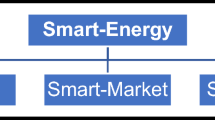Abstract
The Blockchain paradigm applied to energy communities represents both a challenge and an opportunity. Indeed, it introduces a new distributed and transparent framework to manage the communities’ services. In the meantime, it guarantees the traceability of the energy produced and consumed, informing consumers of the origins and costs of their supply, making tariffs more transparent with the result of promoting energy flexibility. Blockchain enables a real digitalization of the energy sector, maintaining a high level of trust and compliance. The security of the transaction and the guarantee that the platform on which an energy network is based cannot be tampered with has prompted energy communities to start a blockchain-based system. The paper proposed a blockchain-based open and transparent ecosystem for smart energy communities within different and several actors interfacing thanks to the blockchain system and its services interact in a natural and disintermediate way. It allows, in a peer-to-peer (p2p) manner, to implement participatory logic aimed at reducing and self-consumption of energy and direct participation of citizens in the electricity system. A proof of concept is created and tested using an innovative smart legal contract framework created by Trakti and a scalable blockchain ecosystem thanks to the Trakti platform through an end-to-end approach. Indeed, this platform implements a new way of automatically managing and incentivizing the energy community via a smart contract connecting actual data and services that the smart energy community can consume using community energy tokens. The approach demonstrates how the new smart legal contract makes it possible to define an energy token, which remunerates the energy exchanges in communities between producers and consumers within a smart grid and converts the energy into community services.
Access this chapter
Tax calculation will be finalised at checkout
Purchases are for personal use only
Similar content being viewed by others
References
Energy communities [online] Energy-European Commission. Available at: https://energy.ec.europa.eu/topics/markets-and-consumers/energy-communities_en
Kounelis, I., Giuliani, R., Geneiatakis, D., Di Gioia, R., Karopoulos, G., Steri, G., Neisse, R., Nai Fovino, I.: Blockchain in energy communities, a proof of concept. EUR 29074 EN, Publications Office of the European Union (2017). ISBN 978-92-79-77773-8. https://doi.org/10.2760/121912, JRC110298
Merlinda, A., et al.: Blockchain technology in the energy sector: a systematic review of challenges and opportunities. Renew. Sustain. Energy Rev. 100, 143–174 (2019)
Mannaro, K., Pinna, A., Marchesi, M.: Crypto-trading: blockchain-oriented energy market. AEIT International Annual Conference. IEEE (2017)
Rapuano, A., Iovane, G., Chinnici, M.: A scalable Blockchain based system for super resolution images manipulation. In: 2020 IEEE 6th International Conference on Dependability in Sensor, Cloud and Big Data Systems and Application, DependSys 2020, pp. 8–15 (2020). ISBN: 978-172817651-2
Iovane, G., Nappi, Chinnici, M., et al.: A novel blockchain scheme combining prime numbers and iris for encrypting coding. In: IEEE 17th International Conference on Dependable, Autonomic and Secure Computing, IEEE 17th International Conference on Pervasive Intelligence and Computing, IEEE 5th International Conference on Cloud and Big Data Computing, 4th Cyber Science and Technology Congress, DASC-PiCom-CBDCom-CyberSciTech 2019, pp. 609–618 (2019), ISBN: 978-172813024-8
Zhou, Q., Huang, H., Zheng, Z.: Solutions to scalability of blockchain: a survey. Gen (2020). https://doi.org/10.1109/ACCESS.2020.2967218
Nakamoto, S.: Bitcoin: a peer-to-peer electronic cash system. (2008)
Wood, G.: Ethereum: a secure decentralised generalised transaction ledger. Ethereum Project Yellow Paper 151, 1–32 (2014)
Cachin, C.: Architecture of the hyperledger blockchain fabric. In: Proceedings of the 3rd Workshop on Distributed Cryptocurrencies Consensus Ledgers, vol. 310 (2016)
Wang, H., Zheng, Z., Xie, S., Dai, H.N., Chen, X.: Blockchain challenges and opportunities: a survey. Int. J. Web Grid Services 14, 352 (2018)
Zheng, P., Zheng, Z., Luo, X., Chen, X., Liu, X.: A detailed and real-time performance monitoring framework for blockchain systems. In: Proceedings of 40th International Conference on Software Engineering Software Engineering: Practice-ICSE-SEIP, pp. 134–143 (2018)
The Scalability Trilemma in Blockchain, Sep. 2019, [online] Available: https://medium.com/@aakash_13214/the-scalability-trilemma-in-blockchain-75fb57f646df
Gilbert, S., Lynch, N.: Brewer’s conjecture and the feasibility of consistent available partition-tolerant web services. SIGACT News 33(2), 51 (2002)
Li, X., Jiang, P., Chen, T., Luo, X., Wen, Q.: A survey on the security of blockchain systems. Future Gener. Comput. Syst.
Chinnici, M., Telesca, L., Islam, M., Georges, J.-P.: Blockchain-Based smart energy communities: operation of smart legal contract. In: Proceeding: 24th HCI International Conference, HCI’22 Conference, Thematic area Universal Access in Human-Machine Cooperation and Intelligent Environments, LNCS 2022, pp. 324–336, vol 13520. https://doi.org/10.1007/978-3-031-18158-0_24
Iannis, K. et al.: Blockchain in Energy Communities, JRC Technical reports (2017)
Author information
Authors and Affiliations
Corresponding author
Editor information
Editors and Affiliations
Rights and permissions
Copyright information
© 2023 The Author(s), under exclusive license to Springer Nature Switzerland AG
About this paper
Cite this paper
Chinnici, M., Telesca, L., Islam, M., Georges, JP. (2023). Scalable and Transparent Blockchain Multi-layer Approach for Smart Energy Communities. In: Prieto, J., Benítez Martínez, F.L., Ferretti, S., Arroyo Guardeño, D., Tomás Nevado-Batalla, P. (eds) Blockchain and Applications, 4th International Congress . BLOCKCHAIN 2022. Lecture Notes in Networks and Systems, vol 595. Springer, Cham. https://doi.org/10.1007/978-3-031-21229-1_18
Download citation
DOI: https://doi.org/10.1007/978-3-031-21229-1_18
Published:
Publisher Name: Springer, Cham
Print ISBN: 978-3-031-21228-4
Online ISBN: 978-3-031-21229-1
eBook Packages: Intelligent Technologies and RoboticsIntelligent Technologies and Robotics (R0)




